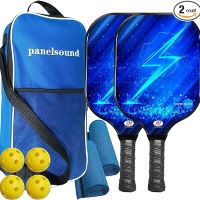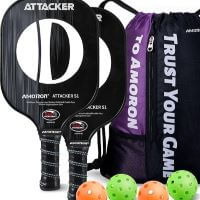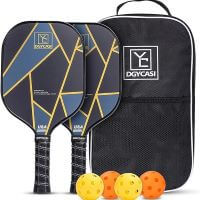Can you put a spin on a pickleball serve? This question has been a topic of discussion among pickleball enthusiasts, particularly in light of the ban on putting spin on pickleball serves in 2023.
In this blog post, we are going to explain whether it is legal to put a spin on a pickleball serve or not and why putting a spin on a pickleball serve was banned, the benefits from banning the rule of adding spin on a pickleball serve, and how the spin on a pickleball serve was added before it was banned this year.
You Might Also Like:
Is It Legal to Put Spin on a Pickleball Serve?
As of January 1, 2023, according to the official rules set by USA Pickleball and the International Federation of Pickleball (IFP), the spin serve in pickleball is now considered illegal. According to the updated rule, the server must employ only one hand to “discharge” the ball and execute the serve. If the server visibly imparts spin to the ball during the “discharge,” the portion(s) of the hand making contact with the ball must be “uncovered.” This means that using two hands, a glove, or any other device to impart spin on the ball before hitting it with the paddle is not allowed.
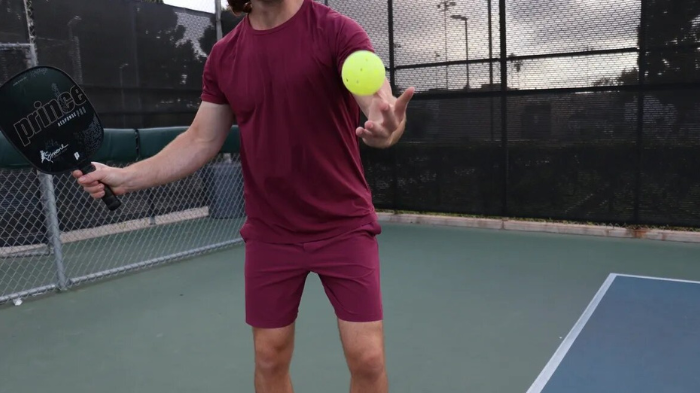
The rationale behind this rule change is to maintain a fair and balanced game. The spin serve had the potential to give a clear advantage to the server and make it challenging for the receiver to return the ball. Furthermore, the spin serve frequently necessitated additional court space and had the potential to cause disruptions to other players. The serve is intended to initiate the game and provide both players with an equal opportunity.
However, it is important to note that other types of serves are still legal and effective in pickleball. You can utilize topspin on your serve, which involves hitting the ball with an upward motion of your paddle, creating a forward rotation. Topspin can assist you in achieving deeper and higher bounces off your shots, making it more challenging for your opponent to return the ball. Moreover, drop shot and volley serves are recognized as legitimate and effective serving techniques in pickleball.
Why It Was Banned to Put a Spin on a Pickleball Serve?
According to multiple sources, USA Pickleball has implemented a ban on the spin serve or pre-spun serve in pickleball starting in 2023. This ban comes after the previous prohibition of the chainsaw serve in 2022. The rule change, specified in Rule 4.A.5, specifically relates to the Volley Serve and explicitly prohibits the application of spin to the ball before striking it for the serve.
The decision to ban the spin serve is based on several reasons:
- The fundamental objective of the serve is to initiate gameplay and commence the match.
- Most players find it challenging to hit or return a spin serve effectively.
- To react to and return a spin serve, players need to have extra court space available.
- The spin serve has been mastered by only a limited number of players, which gives them an unfair advantage.
- The spin serve can be particularly detrimental to amateur players.
It is important to note that the spin serve is now deemed an illegal serve and considered a fault, which can be called by the receiving person or team. However, it is important to acknowledge that certain players may still decide to utilize the spin serve in friendly matches or practice sessions, as long as they possess a thorough awareness of the rule change and its implications.
Benefits of Banning the Putting a Spin to Your Pickleball Serves in 2023
Banning the spin serve in pickleball in 2023 can offer several potential benefits:
Fairness: Many players perceive the spin serve as unfair, especially for those who are less experienced and find it challenging to return. Banning the spin serve promotes a more balanced and enjoyable game for players of all skill levels. Additionally, this rule change eliminates any confusion about whether the spin was generated using the hand or paddle, simplifying the rules and ensuring fairness.
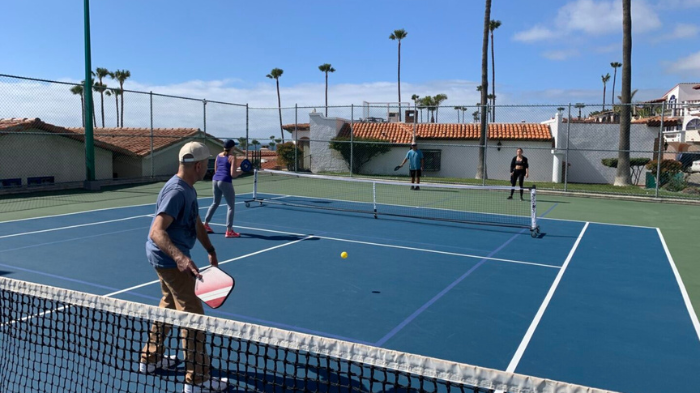
Consistency: By prohibiting the spin serve, it aligns with the original purpose of pickleball as a game that emphasizes strategy and simplicity, focusing on shot placement rather than power and spin. This rule change ensures consistency with other serving rules, such as hitting the ball in an upward arc and keeping the contact below the waist. Ultimately, it preserves the integrity and distinctive nature of pickleball.
Safety: The spin serve can be risky, especially for older players who may have difficulty in returning fast and unpredictable shots. Additionally, generating spin requires extra force and friction, which can result in potential injuries and damage to equipment and the playing surface. Banning the spin serve helps to address these safety concerns, making the game safer for everyone involved.
Pace: The spin serve can slow down the game, resulting in longer rallies and potentially disrupting the flow of play. Banning the spin serve promotes a faster pace, reduces faults and unforced errors, and creates a more dynamic and engaging gameplay experience for players and spectators.
Skill Development: The spin serve can divert attention from crucial elements of the game, including strategy, positioning, teamwork, and diverse shot techniques. When players excessively rely on the spin serve, they may overlook the development of essential skills such as footwork, anticipation, and volleying. By encouraging a decreased reliance on the spin serve, players are inspired to improve their overall game and excel in various areas. This fosters their personal growth as players and enables them to adopt a more comprehensive and balanced playing style.
How the Spin on a Pickleball Serve Was Added?
Before the ban on spin serves in pickleball, players would typically add spin by using different paddle angles and contact points during the stroke. Here’s a general explanation of how spin was added to a pickleball serve:
Grip: Players would start by using a grip that allowed for good control and maneuverability of the paddle. The most common way players grasped the paddle in pickleball was known as the continental grip. It involved clutching the handle diagonally across the palm, akin to how you shake hands with someone.
Contact Point: To add spin, players needed to make contact with the ball at a specific point on the paddle. When performing topspin serves, players would hit the ball slightly below its center, and for backspin serves, they would hit it slightly above its center. Players would experiment with various contact points to determine the amount and type of spin they could generate.
Paddle Angle: Adjusting the angle of the paddle face at the moment of contact was crucial for adding spin. For topspin serves, players would tilt the paddle face slightly forward, so it moved from low to high as it struck the ball. This action imparted a spinning motion that caused the ball to drop more quickly after crossing the net. Conversely, for backspin serves, players would tilt the paddle face slightly backward, so it moved from high to low during contact. This motion generated backspin, making the ball bounce and slow down upon reaching the opponent’s side.
Follow-Through: The way players followed through after hitting the ball also influenced the spin. For topspin serves, they extended their arm and wrist upwards during the follow-through, while for backspin serves, they finished with a downward motion. This follow-through was essential for increasing the spin and controlling the ball’s path.
However, it is important to note that as of January 1st, 2023, the International Federation of Pickleball (IFP) implemented a ban on spin serves due to concerns about fairness and consistency. Therefore, the techniques mentioned above for adding spin to a pickleball serve are no longer allowed in official pickleball competitions governed by the IFP.
FAQs
No, according to the current rules of pickleball, intentionally putting spin on a serve is not allowed. The rules require an underhand serve with an upward arc, eliminating the intentional use of spin. The aim is to promote fairness, consistency, and a level playing field for all players.
Yes, you can use spin on shots such as groundstrokes, volleys, and dinks during pickleball rallies. The restrictions on spin primarily apply to the serve.
The decision to ban spin on pickleball serves was made to maintain fairness and consistency in the game. It prevents players from gaining an unfair advantage through unpredictable ball trajectories and promotes a level playing field for all participants.
Even without spin, there are various ways to improve your pickleball serve. Focus on developing a consistent underhand motion, ensuring proper placement and depth of the serve, and incorporating strategic shot selection to keep your opponents off balance.
Rule changes in any sport are always possible, but as of now, the current rules banning spin on pickleball serves are in place. It is essential to stay updated with any official rule changes or announcements from the governing bodies of pickleball.
Conclusion
Can you put spin on a pickleball serve? Now, you cannot put a spin on a pickleball serve as it was banned from 1st January, 2023. While some players may have been disappointed by the ban on adding spin to pickleball serves, as they enjoyed the challenge and unpredictability it brought, this rule ultimately promotes fairness, consistency, safety, and skill development within the game.
Players are encouraged to explore other aspects of the game and hone their abilities in different areas. By embracing these changes, the game of pickleball undergoes evolution, ensuring an exhilarating and captivating experience for players of every skill level.

